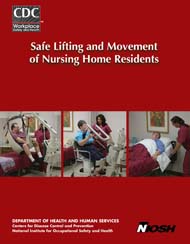Introduction
This guide is intended for nursing home owners, administrators, nurse managers, safety and health
professionals, and workers who are interested in establishing a safe resident lifting program.
Research conducted by the National Institute for Occupational Safety and Health (NIOSH), the
Veterans’ Health Administration (VHA), and the University of Wisconsin-Milwaukee has shown that
safe resident lifting programs that incorporate mechanical lifting equipment can protect workers from
injury, reduce workers’ compensation costs, and improve the quality of care delivered to residents.
This guide also presents a business case to show that the investment in lifting equipment and training
can be recovered through reduced workers’ compensation expenses and costs associated with lost
and restricted work days.
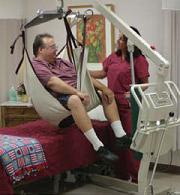 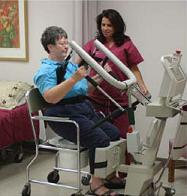 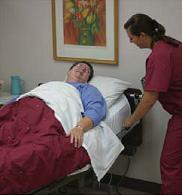
The Challenge of Lifting Residents
in Nursing Homes
One of the major issues in nursing homes is the
frequent heavy lifting and repositioning of
residents that exceed the lifting capacity of most
caregivers1. Numerous studies have shown that
training caregivers how to use proper body
mechanics to lift residents is not an effective
prevention measure because lifting the weight of
adult patients is intrinsically unsafe. Because of
the trend towards shorter hospital stays, residents
who are being transferred to nursing
homes are becoming increasingly frail. Factors
that contribute to the difficulty of lifting and
moving a resident include the size and weight of
the resident, combativeness, and propensity to
fall or lose balance. In addition, performing
resident transfers in the confines of small
bathrooms and rooms cluttered with medical
equipment and furniture works against the
caregiver being able to use good body mechanics.
When lifting or repositioning a resident in
bed, the bed generally prevents the caregiver
from bending his/her knees to assume the proper
posture for lifting. The forward bending
required for many patient lifting and moving
activities places the caregiver’s spine in its most
vulnerable position. Even under ideal lifting
conditions, the weight of any adult far exceeds
the lifting capacity of most caregivers, 90
percent of whom are female.
These conditions contributed to the 211,000
occupational injuries suffered by caregivers in
2003 (Bureau of Labor Statistics, 2003). Because
of the rapidly expanding elderly population
in the U.S., employment for nursing aides,
orderlies, and attendants is projected to increase
by 25% between 2002 and 2012, adding an
estimated 343,000 jobs (Bureau of Labor
Statistics, 2004). Due to the ongoing demand
for skilled care services, musculoskeletal
injuries to the back, shoulder, and upper extremities
of caregivers are expected to increase.
Benefits, Cost, and Effectiveness of a Safe
Resident Lifting Program
(1) What are the benefits of a safe resident lifting program?
The following benefits can be derived from a
safe resident lifting program that includes
mechanical lifting equipment, worker training
on the use of the lifts, and a written resident
lifting policy:
Benefits for Residents
- Improved quality of care
- Improved resident safety and comfort
- Improved resident satisfaction
- Reduced risk of falls, being dropped, friction
burns, dislocated shoulders
- Reduced skin tears and bruises
Benefits for Employers
- Reduced number and severity of staff injuries
- Improved resident safety
- Reduced workers’ compensation medical and
indemnity costs
- Reduced lost workdays
- Reduced restricted workdays
- Reduced overtime and sick leave
- Improved recruitment and retention of
caregivers
- Fewer resources required to replace injured
staff
Benefits for Caregivers
- Reduced risk of injury
- Improved job satisfaction
- Increased morale
- Injured caregivers are less likely to be re-injured
- Pregnant caregivers can work longer
- Staff can work to an older age
- More energy at the end of the work shift
- Less pain and muscle fatigue on a daily basis
(2) How much will it cost to set up a safe resident lifting, handling, and
movement program?
A 100-bed facility can expect to spend $25,000
to $30,000 on portable (not ceiling-mounted)
mechanical lifts depending on how many
residents in your facility require the use of a lift.
As a general rule, one full-body lift should be
provided for approximately every eight to ten
non-weight bearing residents and one stand-up
lift should be provided for approximately every
eight to ten partially-weight bearing residents.
The average cost of a mechanical lift can vary
from $3,000 to $6,000 per lift. The average cost
for a ceiling-mounted lift is approximately
$4,000 per room. An effective combination of
both floor and ceiling lifts is generally accomplished
with a $50,000 to $60,000 investment
per 100 bed facility.
(3) Can a nursing home recover the cost of implementing a safe resident
lifting, handling and movement program?
Cost-benefit analyses demonstrate that the
initial investment in lifting equipment and
employee training can be recovered in two to
three years through reductions in workers’
compensation expenses (Collins et al., 2004;
Tiesman et al., 2003; Nelson et al., 2003; Garg,
1999).
(4) How effective is mechanical lifting equipment in preventing injuries to
caregivers?
Safe resident lifting programs can be highly
effective in reducing a health care worker’s
exposure to heavy loads and awkward working
postures that contribute to back and other
musculoskeletal injuries. Research has shown
that safe resident lifting programs reduce
resident-handling workers’ compensation injury
rates by 61%, lost workday injury rates by 66%,
restricted workdays by 38%, and the number of
workers suffering from repeat injuries (Collins
et al., 2004). Similar findings have been reported
by other investigators (Tiesman et al.,
2003; Nelson et al., 2003; Garg, 1999). Furthermore,
this research has shown an increase in
caregiver job satisfaction, and a decrease in
“unsafe” patient handling practices performed.
Nurses ranked lifting equipment as the most
important element in a safe lifting program
(Nelson et al., 2003). The increase in bariatric
residents has also led lifting equipment manufacturers
to develop equipment with higher
lifting capacities to accommodate the special
needs of some bariatric residents.
(5) What benefits will a safe resident lifting program have for nursing
home residents?
Although some residents may be reluctant to try
new lifting devices, studies have shown that the
use of mechanical lifting equipment increases a
resident’s comfort and feelings of security when
compared to manual methods (Zhuang et al.,
2000; Garg and Owen 1992).
The findings from one study indicated that
residents’ acceptance of a safe lifting program
was moderate when the program was first
(5) What benefits will a safe resident lifting program have for nursing
home residents?
implemented but high at the end of the research
study (Nelson et al., 2003).
Injuries to residents are also reduced because
the mechanical lifts protect residents from being
dropped. Anecdotal information indicates that a
reduction in skin tears and bruises may result
when residents are handled mechanically rather
than manually (Garg, 1999).
Back to Top
Frequently Asked Questions
about Safe Resident Lifting, Handling,
and Movement Programs
(1) Is training in body mechanics alone an effective prevention measure for
caregivers with regard to lifting and transferring residents?
Numerous studies have shown that training
caregivers on how to use proper body mechanics
to lift residents is not an effective prevention measure because lifting the weight of adult
patients is intrinsically unsafe (Nelson et al.,
2003).
(2) Are back belts an effective option for reducing the risk of back or other
musculoskeletal injuries to caregivers?
The effectiveness of using back belts to lessen
the risk of back injury among uninjured workers
remains unproven and may give workers a false
sense of security (Wassell et al., 2000; NIOSH,
1994).
(3) How can nursing home management motivate staff to use lifting equipment
initially and maintain long-term commitment?
- Provide sufficient training on lift usage so that caregivers learn how to properly operate the equipment. Training should be provided to all newly hired caregivers and a plan should be in
place to assess competency in use of the equipment, at least, annually.
- Post a graph to show caregivers the decrease in injuries after the lifts are being used routinely.
- Do not permit manual lifting except in life-threatening circumstances.
- Include caregivers and residents in the selection of lifting equipment.
- Allow caregivers the opportunity to work with different mechanical lifts. Some vendors will
allow equipment to be evaluated on a short-term trial basis.
- Ask maintenance and housekeeping staff to provide their opinion and input on the equipment being considered for purchase.
- Ensure that all shifts are covered by an adequate number of caregivers who have been trained
to use the lifts to help decrease these injuries.
- Follow-up to check if lifting equipment is being used properly.
- Keep equipment readily available and accessible. The number of lifts required will depend on
the level of physical dependency among the residents. As a general rule, one full-body lift should be provided for every eight to ten non-weight bearing residents and one stand-up lift should be provided for every eight to ten partially weight bearing residents (See illustrations of mechanical devices used to transfer residents).
- Provide back-up battery packs on remote chargers as needed so that lifts can be used 24 hours per day while batteries are being recharged.
- Ensure that sufficient slings of the proper size are available.
- Consider a single-patient-use disposable sling for each resident; reimbursement may also be available.
- Store equipment in a convenient location.
- Implement a routine maintenance program to ensure equipment is kept in good working order (the maintenance program should include tagout and repair procedures for broken equipment).
- Provide training to a knowledgeable person with enthusiasm and leadership capabilities on each shift to serve as a peer safety leader. A peer safety leader can provide education, bedside assessments, and training/re-training on lifting equipment.
Mechanical Devices Used to Transfer Residents
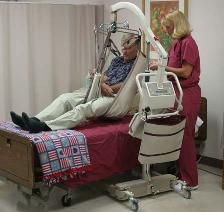 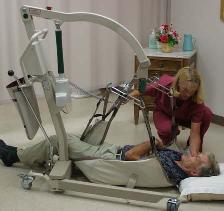
Safe Lifting and Movement of Nursing Home Residents
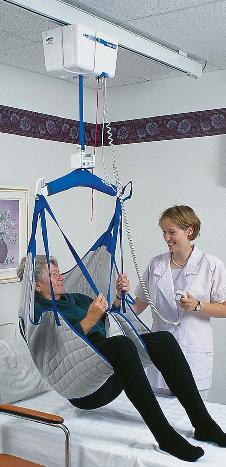
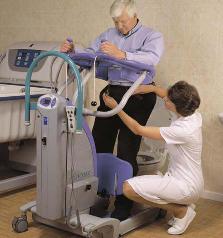
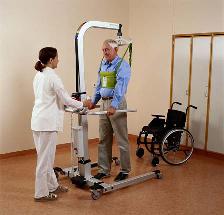
(4) What type and how much training is necessary to ensure that all of the
caregivers are prepared to use lifting equipment?
Training should focus on how to use the lifting
equipment for residents with a range of physical
limitations, and should include hands-on
practice. Caregivers should be required to
demonstrate that they are proficient in the use of
the lifting equipment for residents with a range
of disabilities. Training is generally provided
by the lifting equipment manufacturer when
equipment is purchased; however, a member of
the care giving staff and/or peer safety leaders
should be trained in all aspects of lifting equipment
usage and should be prepared to provide
periodic refresher training to existing staff and
newly hired caregivers.
(5) Is it helpful to have a written resident lifting policy?
Yes, a written policy establishes:
- Manual lifting is unsafe for residents and staff and is not permitted,
- Minimum standards for the lifting program,
- Transferring needs of each resident are assessed and reassessed as a resident’s transferring needs change,
- The amount of lifting equipment required,
- Requirements to select appropriate lifting methods,
- Training requirements for caregivers,
- Responsibilities for all caregivers.
(6) What if a resident refuses to be lifted by a mechanical lift?
Upon admission, it should be explained to the
incoming resident that the nursing home has a
policy requiring the use of a mechanical lift for
non-weight bearing residents. It should be
explained that the lift is for the safety of the
resident and the caregiver. If caregivers are
injured, it will compromise the nursing home’s
ability to provide quality care. If a resident
refuses to be lifted with a mechanical lift, the
caregiver, therapy staff, and the social worker
should spend extra time with the resident to
secure their trust and to help them understand
that the lifts increase resident and staff safety.
The social worker, administrator, nurse manager,
or therapy staff can intervene with the
resident’s family by explaining the benefits of
lifts for the resident and the caregivers. Offer to
demonstrate the lift using a family member, and
explain that the use of the lift will not compromise
the resident’s dignity. Furthermore, the
resident’s comfort and security may be improved,
while reducing his/her risk of injury.
(7) What approaches promote the effective implementation of a safe
resident lifting program?
It is important to include caregivers and staff
from all departments in the program development.
Keeping the staff trained and competent
in the use of the mechanical lifting equipment is
a key component of a successful program. Lack
of compliance may result if newly hired employees
do not know how to use the equipment.
Preventive maintenance and prompt repair of
improperly functioning equipment will facilitate
the use of lifting equipment. Ensure that
enough lifts are provided and that they are
conveniently stored so that they will be available
when needed. Also, slings can be lost,
especially if the slings are sent offsite to be
laundered. Consider laundering slings on site or
use disposable slings. Successful nursing homes
establish a mechanism, such as peer safety
leaders, to champion the program and provide
on-going training, monitor problems, and assist
in resolving problems on an ongoing basis. This
helps to facilitate staff buy in and consistent
usage of the equipment.
(8) What impact will mechanical lifting equipment have on resident
assaults to caregivers?
Findings from a NIOSH study (Collins et al.,
2004) indicated that resident assaults on
caregivers decreased after the implementation of
mechanical lifting equipment to lift and transfer
residents. After caregivers are sufficiently
trained, residents trust that caregivers can move
them comfortably and safely. This may partially
explain the reduction in assaults from residents.
It should be noted that there are exceptions and
some residents who are confused or disoriented
may violently oppose being lifted with a mechanical
lift (Collins et al., 2004).
(9) Does it take more time to use a mechanical lift to move a resident than
to manually transfer the resident?
It is quicker to manually transfer a resident.
However, using a mechanical lift is much safer
for the caregiver and provides a more comfortable
and secure transfer for the resident. The
long-term health and wellness of the caregiver
will be much greater over the long-term by
taking a few extra minutes to lighten the daily
burden of work. Much of the extra time to use a
mechanical lift is spent in locating and bringing
the lift to the bedside. Convenient storage and
adequate numbers of mechanical lifts greatly
reduce the time required to move a resident and
increases staff adherence to the program.
Ceiling-mounted lifts address the concern of
bringing the lift to the bedside because they are
conveniently stored in the resident’s room.
(10) How should residents be evaluated to assign an appropriate lifting
device to the resident?
The first step is to assess the transfer needs of
the resident which should be reassessed if the
resident’s condition changes. The assessment
should consider the dependency level of the
resident, the size of the resident, the resident’s
cognitive status, and weight bearing ability.
Once the resident’s transferring needs have been
assessed, it is critical that the information be communicated to the caregivers responsible for
lifting the resident. OSHA and VHA documents
contain transfer-specific algorithms to help
assess the appropriate transferring needs for the
resident. These algorithms can be accessed at
the Web sites listed in the "More Information
Section".
Conclusion
This document provides information for nursing
home owners, administrators, nurse managers,
safety and health professionals, and workers
who are considering establishing a safe resident
lifting program. Research has shown that
incorporating mechanical lifting devices into a
safe resident lifting program decreases caregiver
injuries, lost workdays, workers’compensation
costs, and employee turn-over while improving
employee morale and the quality of care for
residents. The initial investment in the equipment
and training is quickly recovered because
of the reduced injury costs to caregivers.
More Information about Setting Up a Safe
Resident Lifting Program Using Mechanical
Equipment can be Found at:
Patient Care Ergonomics Resource Guide: Safe Patient Handling and Movement, Veterans Administration
Hospital, Tampa, Florida and Department of Defense, 2001. www.patientsafetycenter.com/ Safe%20Pt%20Handling%20Div.htm
OSHA, Guidelines for Nursing Homes: Ergonomics for the Prevention of Musculoskeletal Disorders,
OSHA 3182, 2003. www.osha.gov/ergonomics/guidelines/nursinghome/
Handle with Care: The American Nurses Association’s Campaign to Address Work-Related Musculoskeletal
Disorders. http://www.nursingworld.org/handlewithcare/brochure.htm
References
Collins JW, Wolf L, Bell J, Evanoff B [2004]. An Evaluation of a “Best Practices” Musculoskeletal
Injury Prevention Program in Nursing Homes. Injury Prevention 10:206-211.
Department of Health and Human Services, Public Health Service, Centers for Disease Control and
Prevention, National Institute for Occupational Safety and Health [1994]. Workplace Use of Back
Belts – Review and Recommendations, NIOSH, Pub No. 94-122, 1994.
Garg A [1999]. Long-Term Effectiveness of “Zero-Lift Program” in Seven Nursing Homes and One
Hospital, Contract No. U60/CCU512089-02. http://www2.cdc.gov/nioshtic-2/Nioshtic2.htm.
Garg A, Owen BD, [1992]. Reducing Back Stress to Nursing Personnel: An Ergonomics Intervention
in a Nursing Home. Ergonomics 35:1353-1375.
Lagerstrom M, Hansson T, Hagberg M [1998]. Work-Related Low Back Problems in Nursing.
Scandinavian Journal of Work and Environment and Health 24(6):449-464.
Nelson A, Fragala G, Menzel N [2003a]. Myths and Facts about Back Injuries in Nursing, American
Journal of Nursing, 103 (2):32-40.
Nelson A, Matz M, Chen F, Siddharthan K, Lloyd J, and Fragala G [2003b]. Research Report: A
Multifaceted Ergonomics Program to Prevent Injuries Associated with Patient Handling Tasks in the
VHA.
Occupational Safety and Health Administration Web site: http://www.osha.gov/ergonomics/guidelines/ nursinghome/intro2.html
Tiesman H, Nelson A, Charney W, Siddharthan K, Fragala G [2003]. Effectiveness of a Ceiling mounted
Patient Lift System in Reducing Occupational Injuries in Long Term Care. Journal of
Healthcare Safety 1 (1): 34-40.
U.S. Department of Labor Bureau of Labor Statistics [2003].Total Recordable Occupational Injury
Cases in Nursing and Residential Care Facilities. Available at http://www.bls.gov/data/home.htm (Accessibility verified 02/04/05)
U.S. Department of Labor, Bureau of Labor Statistics [2004]. February 2004 Monthly Labor Review,
Table 4 – Occupations with the largest job growth, 2002-2012. Available at http://www.bls.gov/emp/ emptab4.htm (Accessibility verified 07/21/05).
Wassell JT, Gardner LI, Landsittel DP, Johnston JJ, Johnston JM [2000]. A Prospective Study of
Back Belts for Prevention of Back Pain and Injury. Journal of the American Medical Association
284(21):2727-2732.
Zhuang Z, Stobbe TJ, Collins JW, Hsiao H, Hobbs, G [2000]. Psychophysical Assessment of
Assistive Devices for Transferring Patients/Residents. Applied Ergonomics 31:35-44.
This document is in the public domain and
may be freely copied or reprinted.
Disclaimer
Mention of any company or product does not constitute endorsement by the National Institute for Occupational Safety and Health (NIOSH). In addition, citations to Web sites external to NIOSH do not constitute NIOSH endorsement of the sponsoring organizations or their programs or products. Furthermore, NIOSH is not responsible for the content of these Web sites.
Ordering Information
To receive documents or other information about occupational safety and health topics, contact
NIOSH at:
NIOSH-Publications Dissemination
4676 Columbia Parkway
Cincinnati, Ohio 45226-1998
Telephone: 1-800-35-NIOSH (1-800-356-4674)
Fax: 513-533-8573
E-mail: pubstaft@cdc.gov
or visit the NIOSH Web site at www.cdc.gov/niosh
DHHS (NIOSH) Publication Number 2006-117
February 2006
Acknowledgments
The authors of this document would like to convey special thanks to the following individuals for their contribution and review of the document.
Contributors:
Laurie Wolf, MS, CPE
Certified Professional Ergonomist
BJC Health System
BJC Corporate Health Services
St. Louis, Missouri
Jennifer Bell, PhD
Epidemiologist
Centers for Disease Control and Prevention
National Institute for Occupational Safety and Health
Division of Safety Research
Morgantown, West Virginia
Brad Evanoff, MD, MPH
Associate Professor of Medicine
Director, Division of General Medical Sciences
Washington University-School of Medicine
St. Louis, Missouri
Arun Garg, PhD, CPE
Professor and Director of the Ergonomics Laboratory
Industrial and Manufacturing Engineering Department
University of Wisconsin – Milwaukee
Milwaukee, Wisconsin
Thomas W. Waters, PhD, CPE
Chief, Human Factors and Ergonomics Section
Centers for Disease Control and Prevention
National Institute for Occupational Safety and Health
Division of Applied Research and Technology
Cincinnati, Ohio
Reviewers:
Bill Borwegen, MPH
Director, Occupational Health and Safety
Service Employees International Union
Washington, DC
Guy Fragala, PhD, PE, CSP
Director of Compliance Programs
Environmental Health and Engineering, Inc.
Newton, Massachusetts
Pamela Hagan, MSN, RN
Chief Programs Officer
American Nurses Association
Silver Spring, Maryland
Anne Hudson, RN, BSN
Work Injured Nurses’ Group (WING) USA
Coos Bay, Oregon
Joe Joliff, BS
Retired Administrator
Wyandot County Nursing Home
Upper Sandusky, Ohio
Joanna Sznajder, PhD, CPE
U.S. Department of Labor
Occupational Safety and Health Administration
Directorate of Standards and Guidance
Office of Physical Hazards
Washington, DC
The authors would also like to thank the nursing home owners, administrators,
nurse managers, and safety and health professionals who participated in a series
of focus groups and evaluated the content and format of this document.
Photo Credits:
Arjo Inc.
E Z Way Inc.
Liko Inc.
BHM Medical
Safe Lifting and Movement
of Nursing Home Residents
by
James W. Collins, PhD, MSME
Associate Director for Science
Division of Safety Research
National Institute for Occupational Safety and Health
Centers for Disease Control and Prevention
Morgantown, West Virginia
Audrey Nelson, PhD, RN, FAAN
Director
Patient Safety Center for Inquiry
James A. Haley Veteran’s Administration Hospital
Tampa, Florida
Virginia Sublet, PhD, RPh
Senior Toxicologist
Oak Ridge Institute for Science and Education
Windermere, Florida
DEPARTMENT OF HEALTH AND HUMAN SERVICES
Centers for Disease Control and Prevention
National Institute for Occupational Safety and Health
Evaluation Form
Please take a few minutes to help us evaluate this NIOSH guide. Thank you.
Back to Top |


